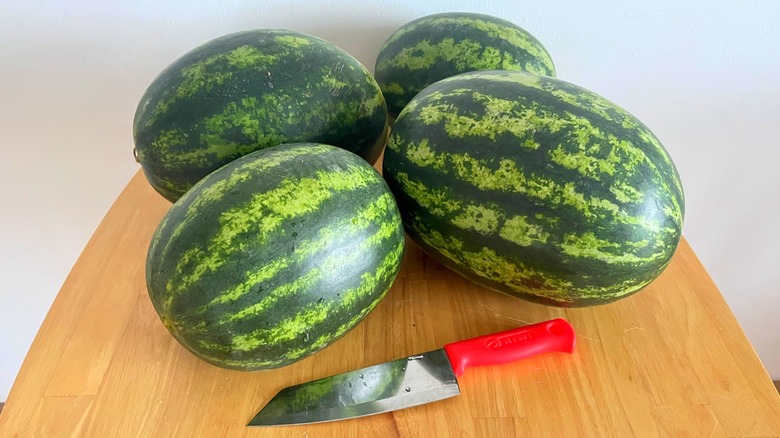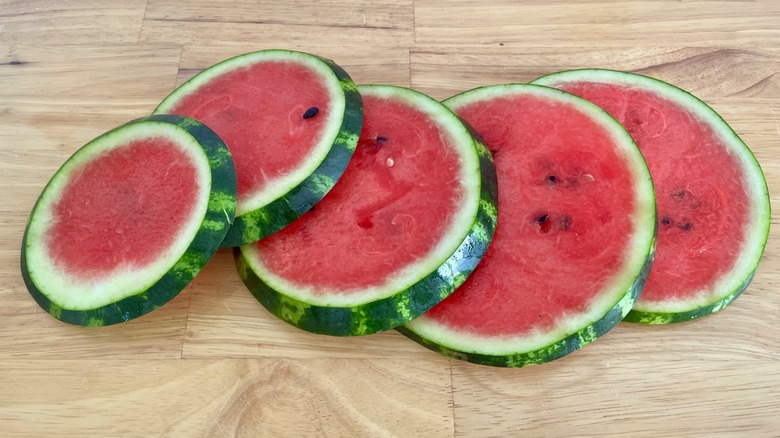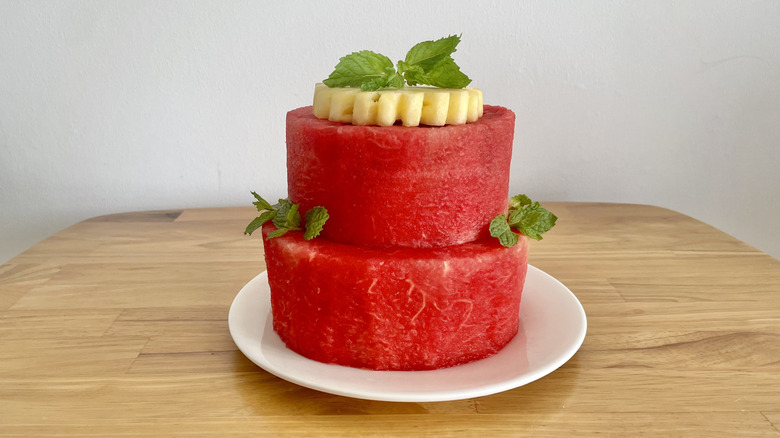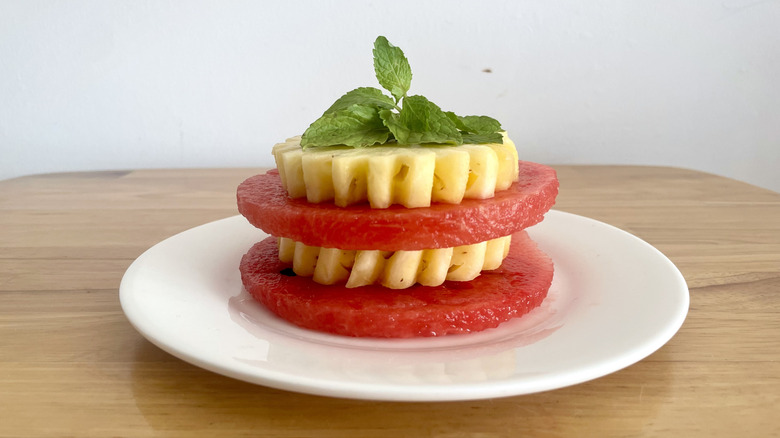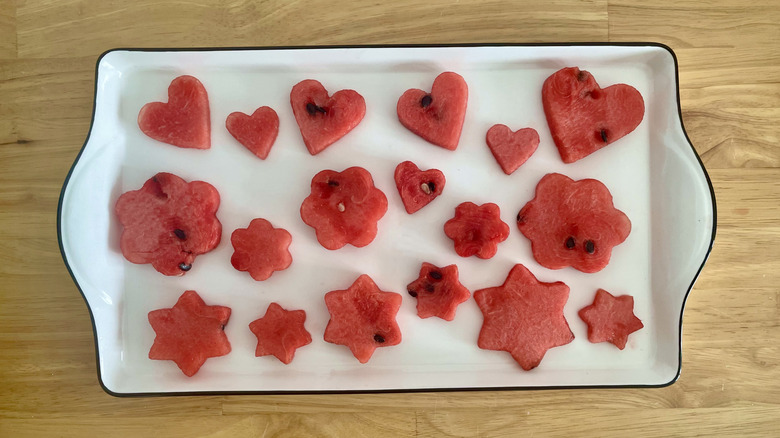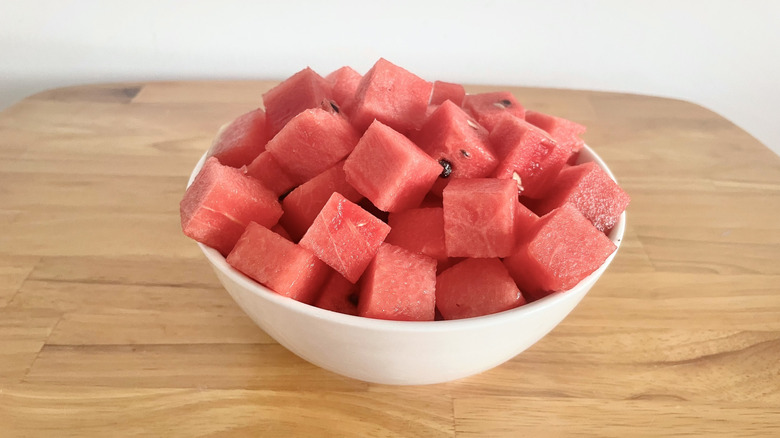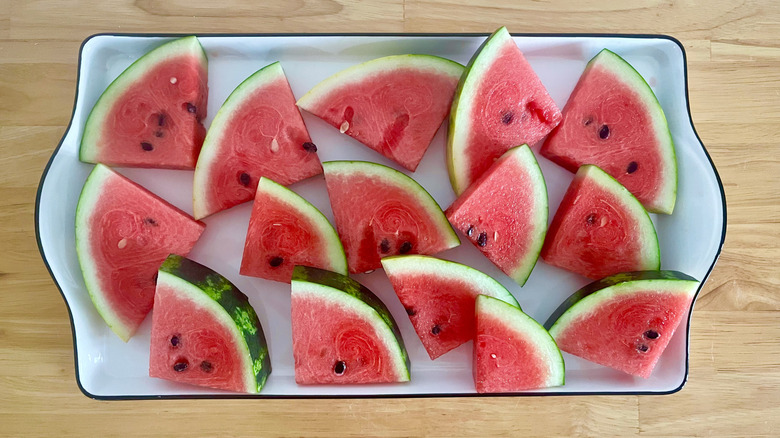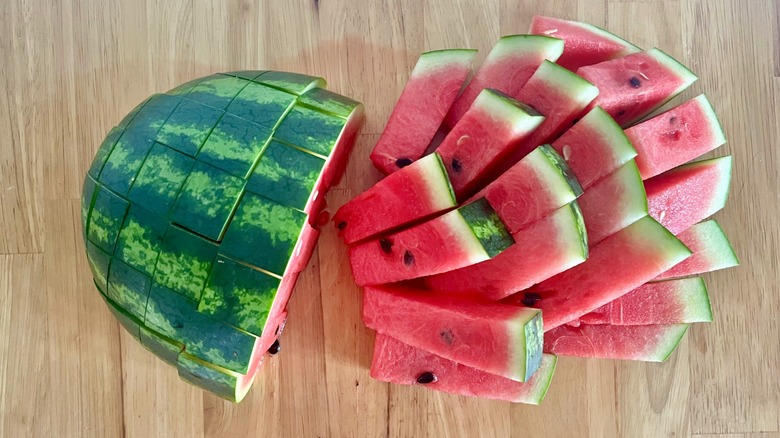9 Watermelon Cutting Methods, Tried And Ranked
We may receive a commission on purchases made from links.
When summer is in full swing, there's nothing quite like biting into a perfectly ripe watermelon. But while this enormous fruit is absolutely delicious, it's also a bit daunting. If you don't have a go-to watermelon cutting method, where do you even begin? I found myself asking this question, which led me down a rabbit hole of research into different watermelon cutting techniques. After discovering just how many approaches exist, I decided to put nine diverse methods to the test.
The first step was choosing the right watermelons. I made sure to avoid common mistakes when buying watermelons at the store, like not factoring in size and weight. I deliberately selected watermelons of various sizes because I felt specific cutting methods would work better with different fruit dimensions. After giving each watermelon a thorough wash, I armed myself with a sharp knife to cut through that rind along with other watermelon slicing materials like smaller knives, ring molds, and even cookie cutters.
Each method has its pros and cons. Some are perfect for entertaining, others excel at portion control — and if I'm being honest, a couple were more laborious than I bargained for. But even my least favorite methods still have their time and place. And ultimately, I've ranked them all based on how easy they were to execute, along with how practical and beautiful the final product was. So read on to find your new, go-to watermelon cutting style and learn the insider tricks to execute it flawlessly.
9. Rounds
Watermelon rounds are just as they sound — cross-sectional slices that look like oversized disks with rinds attached. While the concept sounds straightforward, the execution is anything but. Try slicing through a watermelon while it's rolling around your cutting board like a bowling ball, and you'll quickly understand why this is my least favorite method. Of course, you could always slice off a section of the rind to stabilize the melon, but then you'd lose those picture-perfect circles.
Another reason I'm not crazy about rounds is that while they have aesthetic appeal, they're impractical. Nobody is munching on watermelon rinds, so guests end up breaking the rounds apart anyway. However, rounds do serve a purpose as a stepping stone to watermelon stacks, cookie-cutter shapes, or towers. And although additional slicing is required, watermelon rounds make a refreshing summer pizza with sweet or savory toppings.
This cutting method is best on small watermelons — less circumference means less wrestling. Choose a knife longer than the watermelon's width to avoid sawing back and forth, and use a cutting board with grooves to prevent your melon from sliding. Truthfully, I found cutting evenly shaped rounds tricky, until I realized that rubber bands around the watermelon make an excellent cutting guide. I suggest following the bands down with your knife in one smooth, confident motion for perfect circles. Aim for rounds about an inch thick — any thicker and they become hard to handle, any thinner and they fall apart when picked up.
8. Tower
Watermelon towers make excellent cakes, especially if you're trying to eat healthy or simply prefer fruit over flour. They're nutritious, stunning, and give off an air of celebration. And since they're unexpected, they impress guests. However, despite their Instagram-worthy appeal, I ranked this cutting method lower because it's labor-intensive and requires extra materials. And after the candles are blown out, you'll need to grab that knife again to cut slices.
When making a watermelon tower, aim for two or three tiers. Start by cutting a large watermelon into three equal cross-sections — these cuts determine your tower's height. Fingers crossed the watermelon's interior is in good shape because, although you can safely eat a split watermelon, a giant hole makes it hard to stack neatly. Remove the rind, then shape each section into circles or squares. Ring molds work perfectly for uniform rounds. The chunky middle is your base, while the smaller ends are your upper tiers. Make each level progressively smaller for easy stacking, securing everything with toothpicks or wooden skewers.
However, don't stop there. Your tower is an edible canvas where you can show off those artistic skills. Cascade grapes down the side, or border each layer with berries. Put the rind to use by carving letters and numbers, depending on the occasion. You ultimately want your tower to look like something in a bakery window. As such, this method is best suited for those who have the time and energy to create a culinary masterpiece.
7. Serving boat
Watermelon shells don't get the credit they deserve — they're beautiful and surprisingly functional, which is why I was excited to create a watermelon boat. Why not put that rind to good use? However, watermelon boats are more about the vessel than the actual flesh, and require additional effort and food to complete. Despite this, they offer the perfect serving tray for fruit salads, so avoid wasting all that fresh summer fruit by preparing a salad as soon as you get home.
You've got two boat-building routes: long, horizontal vessels perfect for large, crowd-pleasing spreads, or tall, deep boats perfect for elegant, single-serving dishes like that fancy summer meal. Choose your adventure by halving your watermelon lengthwise or crosswise accordingly. For upright boats, trim just enough rind on the bottom to prevent wobbling. And fair warning, hollowing out the center gets messy, so work over the sink. Don't waste that precious flesh, either. Scoop it into a bowl for fresh juice, or use a melon baller for perfect spheres.
Now that you have your vessel, you should obviously fill it — I kept it simple, but you can get as creative as you like. Combine the watermelon balls with honeydew and cantaloupe for a colorful mixture or carefully arrange fruit slices with edible flowers. For a less conventional approach, try mixing a large green salad inside the natural bowl. Finger foods mean zero dish duty, while fork-and-knife fare may require extra plates.
6. Stacks
Watermelon stacks are ideal for creating a fruit-based sandwich. They make a great starter, particularly on hot summer days when you want something refreshing. They also pair well with unexpected fillings, from tangy cheeses to sweet fruits. Plus, using a ring mold makes the process relatively painless, and the presentation suggests far more effort than the cutting method actually requires. However, I ranked stacks in the middle of the pack since they're not solo acts, requiring more ingredients to come together. I was also surprised by the amount of watermelon I wasted, since I only used the perfectly molded circles.
Creating stacks starts with removing the rind lengthwise so your melon lies flat and steady. Slice crosswise into roughly half-inch rounds. The density should be thin enough to bite through cleanly, but thick enough to support whatever you're piling on top. Once you've cut enough rounds, use your ring molds to punch out uniform circles, like an oversized cookie cutter.
Once you've got stacks, decide how exactly you'd like to use them. Watermelon sandwiches are surprisingly good, and the fruit blends well with a variety of flavors. I kept it super simple with a funky pineapple slice, adding a touch of colorful contrast. However, feel free to think outside the box. Crumbled feta, walnuts, and balsamic vinegar work well, or spread a thin layer of cream cheese and top it with prosciutto. Or to keep things sweet, layer different melons.
5. Cookie cutters
I enjoyed this cutting method because it's just fun. Yes, cubes produce less waste, but cookie-cuttered shapes are unexpected. They transform simple fruit into edible art, and I can't lie, they put a smile on my face purely because they're so cute. Plus, they work well for themed events — think star-spangled watermelons for the Fourth of July, hearts for anniversaries, or flowers for picnics.
Most kitchens have a forgotten collection of cookie cutters, so bust them out and put them to work. If you're deciding between metal and plastic cookie cutters, opt for metal. They're more durable, and slice through fruit flesh more easily. To begin, you'll need to use a separate cutting method to achieve slices of your desired thickness. I recommend cutting your watermelon in half lengthwise, then cutting crosswise into half circles. Keep slices thinner than your cookie cutter's height, or you'll end up struggling to push the cutters out of stubborn fruit – ½-inch slices worked best for me. Anything thinner and you may end up with broken hearts and flimsy flowers.
This cutting method is low effort, high reward, yielding single-sized portions that look professional while requiring zero culinary skills. It's also a great way to rescue awkwardly cut watermelon wedges that would otherwise be tossed. And kids who typically aren't fans of fruits and veggies may be more easily persuaded if that watermelon is shaped like their favorite animal. After all, presentation goes a long way, even for little ones.
4. Cubes
Cubes are a classic watermelon slice that's surprisingly versatile. While not all that creative, I like that this cutting method leaves behind minimal waste and is quite practical. There are several uses for watermelon cubes, from serving them solo to mixing them in fruit salads or skewering them with cheese and other fruits. They also make great frozen refreshers that won't water down drinks like regular ice cubes. Simply pop them in the freezer and add them to water, juices, or blended smoothies.
Creating cubes is surprisingly easy, too. Slice the fruit crosswise, lay each section flat, and remove the rind by working your knife downward around the perimeter (instead of tossing watermelon rinds, pickle them later). Once you've got clean, rindless halves, cut horizontal slices at one-inch intervals across the flesh. Make sure to hold the watermelon firmly from the top so slices don't shift while cutting. Afterward, make perpendicular cuts downward with the same spacing, and voilà: You have an edible checkerboard that falls apart into perfect cubes with a gentle nudge.
Alternatively, you can create cubes from watermelon scraps. When serving watermelon sticks, cube the leftovers and use them in a tossed salad, or freeze them for later. Don't be afraid to experiment with cubes, either. Inch-thick pieces work great for most foods, but ½-inch pieces are better for toddler-friendly snacking or delicate salads. When serving adults, consider serving the cubes alongside toothpicks so fruity fingers don't end up all over your furniture.
3. Wedges
Wedges might be the most popular watermelon cutting method — and for good reason. It's a straightforward slicing technique, and while not flashy, I like that it gets the job done easily and efficiently. The slices end up with built-in handles courtesy of the rind, so you get mess-free eating. Plus, all the flesh is consumed, so there's little to no waste. While I initially thought this cutting method was predictable and a bit boring, the practicality and versatility won me over.
There are several approaches to making wedges. I chose to halve the watermelon lengthwise. From here, decide how big you'd like your wedges based on your watermelon's personality. The watermelon I used was particularly petite, so I chose to simply quarter it, then create inch-thick slices crosswise (an inch seems to be the magic thickness for watermelon slicing). Larger melons can easily yield three wedges per cross-section. For maximum efficiency, slice lengthwise first, then make crosswise cuts while holding the segments together firmly.
Wedges are a stand-alone snack — serve them as is or drizzle lemon juice over watermelon to bring out the sweetness. Also, don't be afraid to experiment with this classic cut. Those craving a spicy-savory element can dip their watermelon wedges in Tajin. Alternatively, create a DIY pizza-style bar, allowing guests to choose from toppings like mozzarella, prosciutto, or balsamic glaze. And thanks to their substantial surface area, watermelon wedges are perfect for grilling at that outdoor cookout, too — with or without toppings.
2. Thin wedges in a quartered watermelon bowl
This cutting method was a trifecta I didn't expect — surprisingly easy, aesthetically pleasing, and effortlessly servable. It was a win-win-win situation that turned the simple watermelon into both a serving tray and a snack, leaving zero dishes in its wake. The convenience is my favorite part: Just plop those quartered sections on the table and let the guests help themselves, like a fruit buffet.
Start by halving your watermelon lengthwise, then quartering it again to create long sections. Here's where you may need to swap out your knife. While I needed a sturdy blade to conquer the rind, separating the flesh from the rind required something more flexible. I ended up using a butter knife, and it did the trick. Make sure to trace the curve where rind meets flesh all the way across, maneuvering at an angle. Once you've freed the flesh, return to the sharp knife to cut clean wedges crosswise. I went for ½-inch pieces and was pleased by the result. It looked beautiful, yet created the perfect bite-to-presentation ratio.
The next step completes this watermelon cutting style. Using a fork or spoon handle to stay hygienic, push alternating slices forward and backward to create a zigzag pattern. Separate enough to make grabbing easy — you don't want party-goers fumbling with the display. And if your guests don't end up finishing the appetizer, don't let that watermelon go to waste. I recommend using leftovers to make boozy watermelon slushies.
1. Long sticks
My favorite watermelon cutting technique is creating long sticks. Although I've always thought of myself as more of a watermelon wedge person, long sticks felt like a simple twist on the standard. It's slightly less expected but just as practical, if not more. After all, large watermelon slices can feel like a commitment for light eaters. But when something is presented in smaller packaging, it's more enticing. It's a simple psychology that makes guests more likely to reach for that snack and keep coming back for more. Plus, with the rind as the handle, there's no need to dirty those fingers.
To achieve long sticks, halve the watermelon lengthwise. Cut inch-thick slices across the melon lengthwise, then repeat this process crosswise, holding the melon firmly together. The melon sticks can be served as is — and if you use a pretty cutting board, you simply need to transfer it to the table. It's an ideal after-school snack that's both healthy and easy to whip up in a jiffy.
Alternatively, you could spread them out over a serving tray and serve them alongside a dip. With this crinkle-cutting knife from Amazon, you can easily cut your watermelon into crinkle fries — perfect for dipping into creamy yogurt. With this tool, you may find it easier to remove the rind first. Yes, it adds a step, but it more closely resembles fries and really delivers that extra wow factor.
